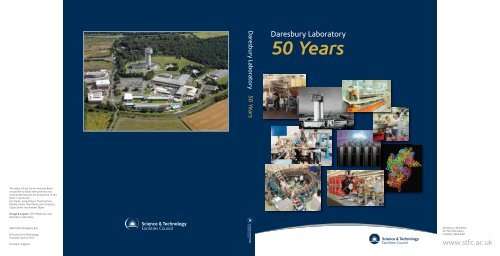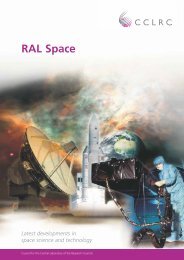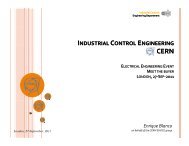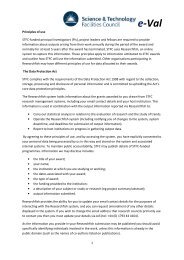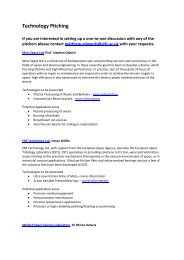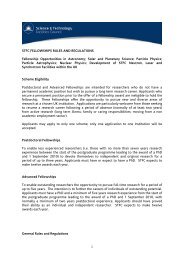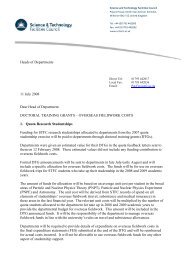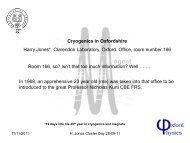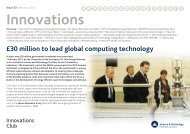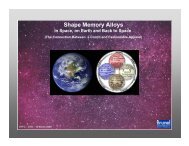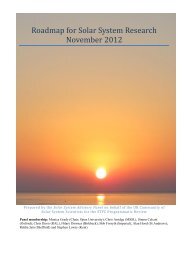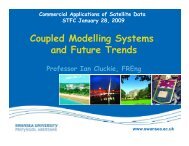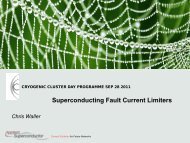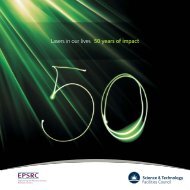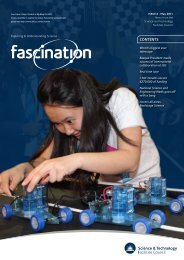50 Years - Science & Technology Facilities Council
50 Years - Science & Technology Facilities Council
50 Years - Science & Technology Facilities Council
You also want an ePaper? Increase the reach of your titles
YUMPU automatically turns print PDFs into web optimized ePapers that Google loves.
Daresbury Laboratory <strong>50</strong> <strong>Years</strong><br />
Daresbury Laboratory<br />
<strong>50</strong> <strong>Years</strong><br />
The editors Tracy Turner and Jane Binks<br />
would like to thank everyone who has<br />
contributed towards the production of this<br />
book, in particular:<br />
Jim Clarke, Greg Diakun, Paul Durham,<br />
Debbie Franks, Neil Marks, John Simpson,<br />
Susan Smith and Andrew Taylor.<br />
Design & Layout: STFC Media Services,<br />
Daresbury Laboratory.<br />
ISBN 978-0-9556616-8-6<br />
© <strong>Science</strong> and <strong>Technology</strong><br />
<strong>Facilities</strong> <strong>Council</strong> 2012<br />
Printed in England<br />
Daresbury Laboratory<br />
Sci-Tech Daresbury<br />
Cheshire, WA4 4AD<br />
www.stfc.ac.uk
Daresbury Laboratory<br />
<strong>50</strong> <strong>Years</strong>
<strong>50</strong> <strong>Years</strong> Daresbury Laboratory<br />
Foreword<br />
Daresbury Laboratory has been in existence for <strong>50</strong> years,<br />
and during which time the staff and scientist associated<br />
with the Laboratory have undertaken a huge variety of<br />
activities, which have shaped the Laboratory of today and<br />
delivered both scientific and societal impact. This book<br />
provides a pictorial chronicle containing highlights of the<br />
journey of challenge, inspiration and endeavour across five<br />
decades.<br />
The journey began in 1960 when, with the backing of strong<br />
research interests from Northern based universities, a high<br />
level science advisory committee chaired by Sir John<br />
Cockcroft recommended to the National Institute for<br />
Research in Nuclear <strong>Science</strong> a design study for an electron<br />
synchrotron at a new laboratory. The project was approved<br />
in July 1962, and Professor Alec Merrison was officially<br />
appointed as Director of the Laboratory. A site was<br />
eventually identified near Daresbury in Cheshire which<br />
offered an exceptionally stable foundation for the proposed<br />
accelerator.<br />
Under the dynamic leadership of Professor Merrison the first<br />
scientific facility, a 5 GeV electron synchrotron accelerator<br />
named NINA (National Institute’s Northern Accelerator) was<br />
completed. In 1967 Prime Minister Harold Wilson formally<br />
opened the Laboratory.<br />
The 1970s saw Professor Alick Ashmore take over as<br />
Director and on securing funding for both the Nuclear<br />
Structure Facility (NSF) and the Synchrotron Radiation<br />
Source (SRS) he was credited with leading the<br />
transformation of Daresbury from a high energy physics<br />
laboratory to an international centre for nuclear physics and<br />
synchrotron radiation.<br />
A new Director, Professor Leslie Green, arrived in 1981 and<br />
the SRS came on line as the world’s first dedicated<br />
X-ray synchrotron radiation source. This facility was hugely<br />
successful, it was developed and upgraded over the<br />
following 28 years and by the time it was switched off in<br />
2008, it had delivered over 2 million hours of science and<br />
had served many thousands of researchers. It was credited<br />
with influencing cleaner fuel, safer aircraft and new<br />
medicines, and contributing to a Nobel Prize or two!<br />
Director Professor Alan Leadbetter arrived in 1988 to lead<br />
Daresbury with an open and active style which was inspiring<br />
to the staff but even he could not prevent the premature<br />
closure of the NSF in 1993, due to a national crisis in<br />
science funding. However the multidisciplinary strengths<br />
built on the delivery and operation of three major facilities<br />
gave the Laboratory resilience. Developments were made to<br />
improve the capabilities of SRS on a number of fronts and<br />
areas such as computational science and engineering grew<br />
in strength.<br />
It was at the end of the millennium that the Laboratory<br />
faced the biggest test when, despite a vigorous campaign<br />
led by Laboratory staff, the government announced that<br />
DIAMOND, the 3rd generation synchrotron replacement for<br />
the SRS, would be built on the Rutherford site. Never the<br />
less a new millennium dawned, there was a real optimism<br />
that exploiting the Laboratory’s strengths in accelerator<br />
science and technology, high performance computing,<br />
nuclear physics, engineering and instrumentation would<br />
lead to further involvement in world-leading science.<br />
Opportunities beckoned. This optimism proved well founded<br />
and the last ten years has seen Daresbury delivering to<br />
projects at the highest level across all these areas.<br />
With the relevance of the Laboratory’s activities to industry<br />
and society growing in importance, Dr. Hywel Price initiated<br />
the processes which led to the formation of the Daresbury<br />
<strong>Science</strong> and Innovation Campus, now Sci-Tech Daresbury.<br />
Professor Colin Whitehouse’s drive and enthusiasm were<br />
fundamental in developing these processes and building the<br />
sustainable partnerships which have created an exciting<br />
productive mix of science and innovation on campus,<br />
attracting over 120 small high-tech companies.<br />
The <strong>50</strong>th anniversary finds an energetic laboratory<br />
developing forefront science, supporting industry and<br />
delivering solutions to grand challenges. This innovative<br />
and inspiring environment is shared with an increasingly<br />
diverse community, including a growing number of research<br />
centres and a rapidly expanding cohort of successful hightech<br />
businesses.<br />
Building on the strengths of our outstanding achievements<br />
in the last <strong>50</strong> years, the Laboratory has a bright future as a<br />
beacon to light up opportunities for UK science and industry<br />
while providing an immense and solid base for further<br />
enterprise, development and growth at Sci-Tech Daresbury.<br />
Professor Susan Smith<br />
Head of Daresbury Laboratory<br />
2
1960s<br />
1962 saw the creation of Daresbury Laboratory, designed as a home for a new 5GeV electron synchrotron,<br />
NINA (National Institute’s Northern Accelerator). Daresbury’s solid sandstone geology and ready access to<br />
cooling water from the nearby Bridgewater Canal made it the perfect location, and construction on the site<br />
began in 1963. This was completed in 1965 and the first beam was accelerated in NINA on 2 December 1966.<br />
Around the same time, Daresbury was positioning itself as a leader in computational science, a position it<br />
maintains to this day, acquiring its first mainframe computer in 1966 at a time when such devices were quite<br />
rare. The then Prime Minister, Harold Wilson, officially opened the Laboratory in 1967, laying down the<br />
foundations for all of the science that has since come out of Daresbury.<br />
3
<strong>50</strong> <strong>Years</strong> Daresbury Laboratory<br />
The letter from Lord Hailsham, the then Minister for <strong>Science</strong> and <strong>Technology</strong>, to Lord Bridges, Chair of the National Institute for<br />
Research in Nuclear <strong>Science</strong> – NIRNS, in July 1962, authorising the commencement of the construction of the Electron Laboratory<br />
at Daresbury Laboratory.<br />
4
1960s<br />
The deep foundations of the<br />
National Institute Northern<br />
Accelerator (NINA)<br />
being cast in 1964.<br />
NINA foundations rising from the ground. These were constructed on the underlying sandstone bedrock – one of the major reasons that the<br />
Daresbury site was chosen.<br />
5
<strong>50</strong> <strong>Years</strong> Daresbury Laboratory<br />
Drilling under the Bridgewater Canal, to lay a cooling water discharge pipe well away from the inlet, led to the canal bed collapsing and parts<br />
of Moore village being flooded!<br />
As the canal drained, the Warrington anglers turned out in force to save the fish.<br />
6
1960s<br />
NINA construction committee meeting in the Laboratory restaurant to celebrate the completion of the project<br />
in December 1965.<br />
In this aerial shot, adjacent to the Restaurant near the canal, you can see A Block construction commencing. B Block was the first office and<br />
laboratory building, shown in the centre of the picture with the accelerator halls and associated workshops forming the heart of the site.<br />
7
<strong>50</strong> <strong>Years</strong> Daresbury Laboratory<br />
The names on the board include Ernest Walton and John Cockcroft who shared the Nobel Prize in physics in 1951 for splitting the atom,<br />
and leading nuclear and particle physicists such as Denys Wilkinson, Brian Flowers, John Holt and Otto Frisch.<br />
In 1966, Professor Sir James Chadwick, winner of the Nobel Prize in Physics for his discovery of the neutron, celebrated his 75th birthday at<br />
Daresbury Laboratory, with a ‘star studded’ list of guests who signed the board.<br />
8
1960s<br />
Laboratory staff positioning magnet coils during the assembly of NINA. These electro magnets (NINA had 40) steered the electron beam and<br />
forced it through a circular path within a vacuum enclosure. Built in 1964 NINA was a 5GeV electron accelerator for particle physics studies.<br />
Every 1/<strong>50</strong>th of a second the electron beam was extracted and sent to one of the four beamlines in the Outer<br />
Hall. The beam sent to the experiments was either the 5GeV electrons or gamma rays (photons), which were<br />
produced by colliding electrons with tungsten targets.<br />
9
<strong>50</strong> <strong>Years</strong> Daresbury Laboratory<br />
The NINA magnet ring after completion in 1966. NINA was 220m circumference (diameter was 70.19m) and 5GeV.<br />
10
1960s<br />
In the main control room, the Rt. Hon Lord Harold Wilson (Prime Minister 1964 - 1970 | 1974 – 1976)<br />
was invited by Professor Alec Merrison, Director Daresbury Laboratory, to switch on NINA in June 1967.<br />
Prime Minister the Rt. Hon Lord Harold Wilson, OBE MP was the constituency MP for Huyton.<br />
11
<strong>50</strong> <strong>Years</strong> Daresbury Laboratory<br />
Children of Laboratory staff at their Christmas party in 1969.<br />
This cutaway diagram shows the electron synchrotron and experimental beamlines in the Outer Hall where particle physics experiments<br />
were undertaken.<br />
The purpose of NINA was to study particle physics, which investigates the nature of matter, and in particular the properties and behaviour<br />
of the elementary particles, of which matter is composed.<br />
NINA pointed a pathway to the quark, a fundamental constituent of matter. Quarks combine to form protons and neutrons.<br />
12
1960s<br />
By 1968 the new A Block laboratory and office block was complete.<br />
The site entrance and security lodge.<br />
13
<strong>50</strong> <strong>Years</strong> Daresbury Laboratory<br />
The 1970s were all about improving facilities and adding capability for Daresbury Laboratory. In this decade<br />
the Laboratory’s computing capability was significantly advanced with the installation of an IBM 370/165 and<br />
the UK’s first Cray-1 supercomputer in 1977. Meanwhile, demand had grown for a dedicated accelerator for<br />
research using synchrotron radiation, and the construction of the Synchrotron Radiation Source (SRS) began<br />
once NINA had closed in 1977. This was the world’s first purpose built synchrotron radiation X-ray source.<br />
Plans were first put forward for a Van de Graaff accelerator in 1972 and construction of the tower took place<br />
throughout this decade.<br />
14
1970s<br />
The ‘Dooley Sculpture’ was erected in 1971 by the Liverpool artist Arthur Dooley. He was given<br />
ten tons of magnetic steel and two 37 inch pole tips (previously designed by Sir John Cockcroft)<br />
taken from the first small cyclotron to operate outside the USA. Dooley used the materials he<br />
had been given to represent a beam splitting the uranium nucleus, adding the ‘Dove of Peace’<br />
emerging among the fission products and emitted neutrons.<br />
A new Daresbury Laboratory theory group was established in 1970 including atomic, molecular and solid state physics<br />
and chemistry, and a youthful Jerry Hopkinson. The group interacted very closely with the Laboratory’s experimental<br />
facilities and pioneered theoretical and computational developments in the scattering of nuclei, of electrons and photons<br />
by atoms and of condensed matter spectroscopies such as X-ray absorption and photoemission. These activities were also<br />
coupled to the university-based research community via the Collaborative Computational Projects – the famous CCPs.<br />
15
<strong>50</strong> <strong>Years</strong> Daresbury Laboratory<br />
The Drawing Office in the seventies shows the tools of the trade that laid down the templates for the cutting edge<br />
engineering which supported the world leading science.<br />
The IBM 360/65 central computer at Daresbury Laboratory. This was the main data analysis system for NINA<br />
and remote access was provided to a number of universities.<br />
16
1970s<br />
The Horizontal Wadsworth Monochromator built to exploit electromagnetic radiation emitted by NINA as part of the Synchrotron Radiation<br />
Facility (SRF) established in the early 1970s. Along with other particle physics accelerators, scientists had been using the synchrotron radiation<br />
(photons), emitted by the electrons traversing around the ring at close to the speed of light, because of its unique properties. By 1975 over <strong>50</strong><br />
scientists with affiliations to more than 16 institutions were at work on NINA exploiting this by product of the particle accelerator.<br />
17
<strong>50</strong> <strong>Years</strong> Daresbury Laboratory<br />
The Chairman of the <strong>Science</strong> Research <strong>Council</strong>, Professor Edwards, visited the SRF.<br />
Professor Edwards was introduced to the SRF by Ian Munro, a founder of the facility,<br />
standing in the background are Alick Ashmore and Bob Voss.<br />
A Synchrotron Radiation Facility Conference in the Lecture Theatre, heralding the growth of a new science area.<br />
18
1970s<br />
Construction of the Nuclear Structure Facility (NSF) begins in the mid-1970s. Built by UK scientists and engineers to a unique design based on a<br />
research and development programme at Daresbury, the NSF was housed in a steel pressure vessel, 45 metres high and 8 metres in diameter,<br />
and was contained in a 70 metre high concrete tower. The concrete tower was ‘slipformed’ to a wall thickness of 1m – 700mm in ordinary<br />
grey concrete with an outer 300mm width of white concrete. The ‘twin’ service tower is 71m high.<br />
19
<strong>50</strong> <strong>Years</strong> Daresbury Laboratory<br />
Schematic of the NSF.<br />
20
1970s<br />
A section of the accelerator pressure vessel being lifted into<br />
the tower.<br />
General view of the NSF tower and buildings. The main framework for the ion source room can be seen at the top of the main tower.<br />
21
<strong>50</strong> <strong>Years</strong> Daresbury Laboratory<br />
The completed NSF tower containing the 45m high accelerator vessel. The large injector at the top housed the ion sources and at<br />
the ground level three large experimental areas accommodated the ion beams radiating from the analysing magnet at the base of<br />
the machine.<br />
The Synchrotron Radiation<br />
Source, a 2GeV electron storage<br />
ring, 96m in circumference, was<br />
approved in 1975. NINA and the<br />
SRF kept running until 1977.<br />
22
1970s<br />
NINA closing party invitation to users and staff in April 1977.<br />
The SRS Linear accelerator the injection system consisted of a 80kV thermionic electron gun feeding a 12MeV electron linac,<br />
the electron beam was then accelerated to 600MeV in a booster synchrotron. The beam was injected into the storage ring at<br />
600MeV and the energy slowly increased over a couple of minutes to 2GeV. The storage ring was filled with electrons once<br />
every 24 hours and the beam current would typically reduce by half over this time.<br />
23
<strong>50</strong> <strong>Years</strong> Daresbury Laboratory<br />
When NINA closed in 1977 work started on the construction of the SRS in the same building.<br />
Overview of the storage ring with a large gantry to house control equipment, built above the ring.<br />
The SRF team in the late 1970’s which included Ian Munro, John West, Pat Ridley, Samar<br />
Hasnain, Joan Bordas, Ken Lea, Bill Smith and Jeff Worgan who all went on to have careers<br />
on the SRS.<br />
24
1970s<br />
Seymour Cray was an<br />
American electrical<br />
engineer and<br />
supercomputer architect<br />
who designed a series of<br />
computers that were the<br />
fastest in the world for<br />
decades. He visited the<br />
Laboratory in 1979 to see<br />
the newly installed Cray-1.<br />
The Cray 1 at DL in 1979 with the IBM 370/165 console in the background. The Cray was capable of<br />
performing over 100 million calculations per second; it was the first machine to merit the title of<br />
supercomputer and heralded in a new era for the computational sciences.<br />
25
<strong>50</strong> <strong>Years</strong> Daresbury Laboratory<br />
Aerial view of the Laboratory in the late 1970’s showing the addition of the tower buildings, the Stores building (far right) , the development<br />
of C Block (central) and the office extension to E Block (bottom right).<br />
The new SRS storage ring starts to take shape with a <strong>50</strong>0 MHz cavity and two of the 16 SRS dipoles in place.<br />
26
<strong>50</strong> <strong>Years</strong> Daresbury Laboratory<br />
1980s<br />
In 1981 the construction, commissioning and testing of the facility that dominates the Daresbury Laboratory<br />
site was completed - the Nuclear Structure Facility was born. Throughout the decade improvements were<br />
made to existing facilities with an expansion of SRS and the addition of more beam lines.<br />
27<br />
27
<strong>50</strong> <strong>Years</strong> Daresbury Laboratory<br />
The Laboratory entrance with the recently completed tower in view. The NSF was inaugurated by the Rt Hon Sir Keith Joseph, MP, on<br />
27 September 1983. Permission to leave the tower standing had to be obtained from the Local Authority and, in June 1992, the condition<br />
requiring the tower to be demolished once it was no longer used for nuclear structure research was formally rescinded.<br />
28
1980s<br />
The SRS was designed as a 2GeV electron storage ring producing intense photon beams from the infrared through to the X-ray region of the<br />
electromagnetic spectrum. The SRS ran from 1981 to 2008 and was the world’s first facility fully dedicated to the exploitation of synchrotron<br />
radiation for fundamental and applied research.<br />
Commemorative plaque for the official opening of the SRS<br />
by the Rt. Hon. Mark Carlisle QC MP on 7 November 1980.<br />
First beam in the SRS as seen on an oscilloscope in the<br />
main control room at 21:30 on 30 June 1980.<br />
29
<strong>50</strong> <strong>Years</strong> Daresbury Laboratory<br />
General view of one of the first SRS beamlines. The Angular Dispersed Electron Spectroscopy experiment was connected to the<br />
right hand fork of beamline 6, whilst another surface science station was at the end of the long straight section of beamline.<br />
30
1980s<br />
SRS Station 1 on beamline 8 was part of a joint agreement between the UK <strong>Science</strong> and Engineering Research <strong>Council</strong><br />
(SERC) and the Netherlands Organisation for Scientific Research (ZWO).<br />
Wiggler 1 contained a 5 Tesla superconducting magnet. This caused the electron beam to bend into a tighter arc stimulating the electrons to<br />
emit higher energy X-rays than those produced by the 16 bending magnets that generated X-rays for the majority of the beamlines. Seven<br />
experimental stations were fed from this wiggler on beamline 9. This wiggler magnet is currently on display in the outside class room at<br />
Daresbury as part of the public and schools engagement programme.<br />
31
<strong>50</strong> <strong>Years</strong> Daresbury Laboratory<br />
The first high resolution X-ray absorption near edge spectra (XANES) for copper and<br />
manganese were recorded at the SRS, compared with theoretical calculations made at<br />
Daresbury, and published in the prestigious scientific journal Nature in 1981.<br />
Image Credit: Nature Publishing Group.<br />
Helios was small but complete synchrotron radiation<br />
source, utilising superconducting technology to<br />
achieve a compact size. The machine was designed<br />
between 1985-87 jointly by Daresbury Laboratory<br />
staff and Oxford Instruments, who then manufactured<br />
them. The first was supplied to IBM in 1991 for<br />
computer chip lithography. The second was sold to a<br />
new synchrotron radiation laboratory in Singapore.<br />
32
1980s<br />
The photons generated by the Synchrotron Radiation Source could be applied to a range of diverse scientific areas hence the variety of beam<br />
lines constructed for experiments aimed at studying the structure and behaviour of materials at the atomic scale. Each beam line was tailored<br />
to exploit a particular part of the electromagnetic spectrum. At its peak there were over 40 experimental stations available for the research<br />
community 24 hrs a day, seven days a week.<br />
Professor Leslie Green, the then Director Daresbury Laboratory speaking at the inauguration of<br />
the NSF by the Rt.Hon Sir Keith Joseph in September 1983.<br />
33
<strong>50</strong> <strong>Years</strong> Daresbury Laboratory<br />
Inside the NSF vessel. The NSF was a tandem electrostatic accelerator producing beams of heavy ions for basic research by university and<br />
Daresbury scientists into the behaviour and properties of the atomic nucleus.<br />
34
1980s<br />
Geoff Meehan sat at the control panel during a visit of the Granada TV film unit to the NSF control room in 1984.<br />
POLYTESSA is a very efficient detector of gamma radiation used to investigate rare atomic nuclei. These<br />
nuclei are produced in nuclear reactions induced by the energetic beams from the NSF striking a target.<br />
The exotic nuclei are selected and identified by the recoil separator and its detection system. The<br />
experimenters were able to identify the heaviest nuclei with equal numbers of proton and neutrons.<br />
35
<strong>50</strong> <strong>Years</strong> Daresbury Laboratory<br />
An undulator is made up of a periodic set of magnets which cause the electrons to emit brighter, more intense light over a narrower<br />
wavelength range.<br />
The visible light emitted by the undulator<br />
was carefully measured when it was first<br />
installed to confirm the performance of the<br />
device. The unusual distribution of colours<br />
shown is due to interference effects which<br />
the undulator relies upon.<br />
36
1980s<br />
An X-ray powder diffraction station on the wiggler beamline 9 of the SRS.<br />
John Inglesfield, Martin Guest and Vic Saunders discussing the Floating Point Systems (FPS) 164<br />
computer, which had an 11 MHz 64-bit processor and 4 MB memory.<br />
37
<strong>50</strong> <strong>Years</strong> Daresbury Laboratory<br />
Inspection of magnets and vacuum vessel<br />
for the high brightness lattice upgrade to<br />
the SRS in 1987. In the 1980's the<br />
demand for an improvement to the<br />
brightness of the source emerged. As<br />
early as 1980, Vic Suller had outlined an<br />
advantageous modification to the<br />
magnetic arrangement of the SRS. By<br />
doubling the number of quadrupole<br />
magnets it would be possible to keep the<br />
SRS competitive even with the new<br />
sources planned for construction in the<br />
1990's elsewhere in the world.<br />
The structure of the foot and mouth disease virus was solved using data acquired at the SRS in the late 1980s, and was the<br />
first animal virus structure to be determined in Europe. In the 1980's the demand for an improvement (to parameters and<br />
characteristics of the source) emerged.<br />
38
1980s<br />
Professor Leslie Green, Director Daresbury Laboratory, cutting<br />
the 25 year celebration cake.<br />
Schematic of the SRS facility in the late 1980s. In this schematic the SRS was just over half its final capacity with 20 stations.<br />
39
<strong>50</strong> <strong>Years</strong> Daresbury Laboratory<br />
SRS annual user meeting poster session, held in the SRS Outer Hall in the late 1980s.<br />
Richard Blake with a Stardent console, a super workstation, and the Convex C220 for multi-user<br />
data processing and computation in 1989.<br />
40
1980s<br />
Kevin Connell and Tom Aitken working on the new superconducting linear accelerator which was installed at the NSF in 1989, to increase the<br />
energy of the beam, which widened the scope of experiments which could be undertaken.<br />
41
<strong>50</strong> <strong>Years</strong> Daresbury Laboratory<br />
This decade saw the Laboratory successfully pioneer the use of emerging parallel computing technologies in<br />
real scientific problems. The Medium Ion Scattering facility (MEIS) and the National Centre for Electron<br />
Spectroscopy and Surface analysis (NCESS) both opened in the 1990s in the wake of the closure of the NSF,<br />
and these cutting edge facilities enhanced Daresbury’s position as a world leader in science. The 1990s also<br />
saw the addition of more wigglers (magnets which affect the beam of radiation) to SRS and Daresbury<br />
Laboratory’s first contribution to a Nobel Prize.<br />
42
1990s<br />
Neville Snodgrass looks on as Baroness Thatcher (Prime Minister 1979 - 1990) visited the Laboratory in 1990 and received a<br />
gift from the apprentices.<br />
43
<strong>50</strong> <strong>Years</strong> Daresbury Laboratory<br />
Professor Alan Leadbetter CBE, starts an annual Daresbury Dash in 1993. The Daresbury Dash was 21 years old in 2012.<br />
Daresbury Laboratory was instrumental in<br />
demonstrating the successful operation of a<br />
national parallel supercomputing service based<br />
on Intel systems installed in the early 1990s.<br />
Jerry Thompson watches Baroness Thatcher, signing the Laboratory’s<br />
visitor’s book.<br />
44
1990s<br />
Alan Leadbetter, Director Daresbury and Bill Gelletly, Head of the NSF, visit the machine operators in the control room. These include<br />
Tom Aitken, Bill Silversides, Brian Blackwell & Tom Joy.<br />
EUROGAM was a UK - France collaboration to build an array of gamma-ray detectors.<br />
45
<strong>50</strong> <strong>Years</strong> Daresbury Laboratory<br />
The Medium Energy Ion Scattering (MEIS) facility. MEIS enabled the investigation of the surface structure and properties of crystalline<br />
materials using an ion beam probe.<br />
This magnet generated a field of 6 Tesla pushing the X-ray photon energy even higher than on beamline 9. Five<br />
experimental stations were built on beamline 16.<br />
46
1990s<br />
Sparks inside the tank of the Van de Graaff accelerator. The high voltage held at the centre of the<br />
accelerator discharges in a similar way that a lightning bolt discharges a cloud. The centre terminal was<br />
charged up to 20 million volts.<br />
The NSF was switched off for the last time at the end of March 1993, by Tom Joy and John Beech. During the lifetime<br />
of the Facility beams of 39 elements, from hydrogen to uranium, were generated and when the different isotopes are<br />
counted the number of species totalled 84.<br />
47
<strong>50</strong> <strong>Years</strong> Daresbury Laboratory<br />
SRS Station 7.4 was used to develop X-ray detector systems with applications in the<br />
understanding of catalytic reactions.<br />
Nobel Prize winner, Sir Nevill Mott, visited<br />
the Mott polarimeter on Station 1.2 of the<br />
SRS. He was in his 90th year and it was the<br />
first and only time that he ever saw a Mott<br />
polarimeter, which was used in the study<br />
of magnetic materials.<br />
48
1990s<br />
Inside the surface science experimental chamber on SRS station 6.1.<br />
Professor Alan Leadbetter CBE,<br />
Director Daresbury Laboratory 1988<br />
- 1994, was awarded a CBE in the<br />
1994 New Year Honours list.<br />
One of the first advanced<br />
engineering X-ray<br />
monochromator designs<br />
developed for the SRS was<br />
exploited at other light sources<br />
in the world, for example at the<br />
Trieste facility in Italy.<br />
49
<strong>50</strong> <strong>Years</strong> Daresbury Laboratory<br />
The first Nobel Prize associated with Daresbury<br />
Laboratory. Sir John Walker won a share of the<br />
1997 Nobel Prize for Chemistry for solving the<br />
structure of the F1 ATPase enzyme using the SRS.<br />
The high resolution Scienta ESCA300 X-ray spectrometer arrived from ICI Wilton as part of the setting up of a new Research Unit for Surfaces,<br />
Transforms and Interfaces (RUSTI) in the mid-1990s. The centre later became known as National Centre for Electron Spectroscopy and Surface<br />
analysis (NCESS).<br />
<strong>50</strong>
1990s<br />
In 1998 SRS stations 6.1 and 6.2 were closed to make way for a new facility known as PHOENIX which<br />
received more intense radiation generated by a newly installed multipole wiggler device in the SRS.<br />
HRH Prince Philip, the Duke of Edinburgh, visited the Laboratory in July 1998.<br />
51
<strong>50</strong> <strong>Years</strong> Daresbury Laboratory<br />
The final set of improvements to the<br />
SRS machine came in the form of<br />
multipole wiggler magnet arrays<br />
which were designed to enhance<br />
the intensity of the X-ray beams<br />
produced. The first two were<br />
installed for beamlines 6 and 14.<br />
During 1999 trade unions at Daresbury Laboratory led a campaign to secure the new Diamond synchrotron at the Laboratory.<br />
The Daresbury designed facility now operates as the UK National Synchrotron Source.<br />
52
2000s<br />
The new millennium marked a new era for Daresbury Laboratory. In March 2000 the decision was taken to<br />
locate the Diamond Light Source synchrotron in Oxfordshire and, shortly afterwards, to build the SuperSTEM<br />
electron microscopes at the Laboratory. In 2002 HPCx, a national supercomputing service, was located at the<br />
Laboratory. This called on the Laboratory’s expertise in operating and writing code for parallel computers. The<br />
decade also saw a close relationship form between Daresbury Laboratory and the North West Regional<br />
Development Agency (NWDA) and this lead to the establishment of the Daresbury Innovation Centre designed<br />
to promote knowledge exchange between new science and technology businesses and the skills and expertise<br />
present in the Laboratory. The Cockcroft Institute, a world leading centre for particle accelerator science and<br />
technology, opened in 2006.<br />
53
<strong>50</strong> <strong>Years</strong> Daresbury Laboratory<br />
Lord Sainsbury of Turville inaugurated the first SuperSTEM high resolution microscope facility at the Laboratory in 2002.<br />
The world’s largest model of DNA measures 10.78 metres high and<br />
includes 2<strong>50</strong> base pairs. It was created by Keele University and<br />
Daresbury Laboratory and was unveiled at the Potteries Shopping<br />
Centre in Hanley, Stoke on Trent on 9 March 2002.<br />
Daresbury Laboratory engineers developed one of the most<br />
advanced X-ray detection systems for the high data rates<br />
generated with advanced synchrotron sources. The system is<br />
known as RAPID and has been exploited at Diamond, in Japan<br />
and Europe.<br />
54
2000s<br />
A wooden shovel, dating from the early bronze age, survived in a remarkable state of preservation in the copper mines of Alderley Edge,<br />
Cheshire. Other historic timbers recovered from the mines, whilst still intact, have fared less well. An X-ray investigation, using the SRS<br />
station 16.5, measuring the copper and arsenic chemical speciations provided clues to the methods by which metals from the mining<br />
environment entered the wood of the shovel and ensured its survival. Pictured here with Andy Smith. Following the closure of the SRS in<br />
2008 the station was gifted to the Museum of <strong>Science</strong> and Industry in Manchester for display in 2013.<br />
HPCx began operation at Daresbury, in a collaboration with the University of Edinburgh, in 2002 as the 9th most powerful<br />
computer in the world.<br />
55
<strong>50</strong> <strong>Years</strong> Daresbury Laboratory<br />
A further multipole wiggler was installed in the SRS to create a new beamline for protein crystallography, which was commissioned in 2004.<br />
The station contained a new MAR desktop beamline with CryoSampleChanger, capable of storing up to 19 samples at time.<br />
Samar Hasnain looks on as Sir Tom Blundell and SRS Director Ian Munro cut the cake to celebrate 25 years of SRS operations.<br />
56
2000s<br />
The Accelerators and Lasers In Combined Experiments (ALICE) facility was conceived as a prototype facility for new advanced light<br />
sources. Key components were assembled in clean room conditions.<br />
ALICE magnets - receiving the equipment are Vic Suller, Elaine Seddon, Wendy Flavell, Mike Poole,<br />
Peter Weightman, Nick Johns and Hywel Price, the then Director Daresbury<br />
57
<strong>50</strong> <strong>Years</strong> Daresbury Laboratory<br />
ALICE (originally known as ERLP (Energy Recovery Linac Prototype)) under construction. ALICE was the first Energy Recovery Linac<br />
accelerator to be built in Europe. This new type of accelerator can generate much brighter electron beams than conventional<br />
synchrotrons and is being pursued by many laboratories around the world.<br />
Sir David King, the then Chief Scientific Advisor, opened the <strong>Science</strong> and Innovation Centre in 2006. Watching were Colin Whitehouse,<br />
Director Daresbury and John Wood, the CEO of the <strong>Council</strong> for the Central Laboratories of the Research <strong>Council</strong>s (CCLRC).<br />
58
2000s<br />
Lord Sainsbury of Turville,<br />
the then <strong>Science</strong> Minister,<br />
inaugurated the Daresbury<br />
<strong>Science</strong> and Innovation<br />
Campus in 2006.<br />
By 2007, the HPCx system had been upgraded (phase 2) delivering a peak computational power of 15.3 million million<br />
calculations per second (teraflops). HPCx delivered scientific output in a diverse range of academic areas including<br />
the design of new materials, computational fluid dynamics, fusion research, atomic and molecular physics and climate<br />
modelling. The service was also used for commercial research work notably in oil reservoir detection and<br />
characterisation.<br />
59
<strong>50</strong> <strong>Years</strong> Daresbury Laboratory<br />
The inauguration of the Cockcroft Institute, a collaboration between Liverpool, Manchester, Lancaster Universities and STFC, was carried out<br />
by Lord Sainsbury of Turville, the then <strong>Science</strong> Minister, on 19 September 2006. Mike Poole and John Dainton were joined by members of<br />
John Cockcroft’s family.<br />
Professor Neil Marks conducting the choir at Daresbury All Saints Church. The choir includes Bill Silversides, Richard Farrow, Neville<br />
Snodgrass, Debbie Franks, Marion Bowler, Neil Bliss, Ron Makin and Mike Miller to name a few.<br />
60
2000s<br />
SRS Directorate - from left to right, Paul Quinn, Elaine Seddon, Pat Ridley & Tracy Turner.<br />
Professor Ian Munro, an early pioneer of synchrotron radiation exploitation at<br />
Daresbury Laboratory, switched off the SRS on 4 August 2008 after over 2 million<br />
hours of beam for science. A message celebrating the 27 years of operation was<br />
displayed on the monitors around the facility during the final hours of operation.<br />
SRS research has advanced many areas from research in HIV/AIDS, Alzheimer’s,<br />
Parkinson’s disease, malaria and Motor Neuron Disease, cleaner fuel and lower<br />
emissions from car exhausts to safer aircraft and even archaeological<br />
conservation.<br />
61
<strong>50</strong> <strong>Years</strong> Daresbury Laboratory<br />
Professor Colin Whitehouse, Director Daresbury, introduces the Duke of Kent, President of the Royal Academy of Engineering, to the<br />
capabilities of STFC during a visit to Daresbury on 13 November 2008. Professor Keith Mason, CEO, <strong>Science</strong> and <strong>Technology</strong> <strong>Facilities</strong> <strong>Council</strong><br />
(STFC) looks on.<br />
For several years children supported by the Chernobyl<br />
Children’s Life Line Charity have visited Daresbury<br />
Laboratory on an annual basis as part of their respite<br />
care. A four week trip to the UK can extend their life<br />
expectancy by as much as 2 years.<br />
62
2000s<br />
The Nobel Prize in Chemistry 2009 was<br />
awarded jointly to Venkatraman<br />
Ramakrishnan, Thomas A. Steitz and Ada E.<br />
Yonath ‘for studies of the structure and<br />
function of the ribosome’. Professor<br />
Ramakrishnan used the SRS in his work on the<br />
Ribosome.<br />
Image Credit: Courtesy of Venkatraman Ramakrishnan<br />
63
<strong>50</strong> <strong>Years</strong> Daresbury Laboratory<br />
Precision alignment of the EMMA acclelerator, EMMA (Electron Machine of Many Applications) is the world’s first non-scaling 'fixed-field<br />
alternating gradient' (FFAG) accelerator, and is capable of acceleration at rates much faster than conventional synchrotrons. Commissioning of<br />
EMMA started in 2010.<br />
64
2010s<br />
In this decade Daresbury Laboratory has continued to add to its facilities and scientific capabilities with the<br />
addition of Blue Joule, the UK’s fastest supercomputer, and with the initiation of construction of the Electron<br />
Beam Test Facility (EBTF) in 2011. The Laboratory also contributed to another Nobel Prize in 2010 when<br />
Graphene earned Andre Geim and Konstantin Novoselov the Nobel Prize for Physics. They had used the<br />
SuperSTEM microscopes at Daresbury Laboratory in some of their work.<br />
65
<strong>50</strong> <strong>Years</strong> Daresbury Laboratory<br />
Susan Smith, Swapan Chattopadhyay and Mike Poole celebrate with the team the first lasing of the ALICE free electron laser in<br />
October 2010. The ALICE Infrared Free Electron Laser (IR-FEL) was one of the major projects ALICE was designed to deliver.<br />
The achievement of FEL lasing in 2010 was the first operation of a FEL driven by an energy recovery accelerator in Europe.<br />
The multidisciplinary team on ALICE celebrate the FEL lasing. The infrared FEL light is being used by an international team led by<br />
Peter Weightman to develop a new technique for cancer diagnosis.<br />
66
2010s<br />
The completed EMMA ring – the world’s first non-scaling fixed field alternating gradient accelerator ( FFAG).<br />
FFAGs accelerate a beam of charged particles from low to high energy with particle orbits at different radii<br />
depending on the energy of the beam.<br />
HRH Prince Andrew, Duke of York, visited Daresbury Laboratory and the Campus in April 2010.<br />
67
<strong>50</strong> <strong>Years</strong> Daresbury Laboratory<br />
The Prime Minister, David Cameron, visited in August 2011 and announced £10M of scientific investment into the Laboratory and the<br />
establishment of a new Enterprise Zone at the Daresbury Campus.<br />
In August 2011, the Laboratory held its first public and family access days, which will become an annual event.<br />
68
2010s<br />
A School <strong>Science</strong> Prize winner being presented her <strong>Science</strong> book by Professor Susan Smith, Head of Daresbury Laboratory in 2012. This is an<br />
annual event where students from around the local area are invited to the Laboratory, chosen by their teacher for their special efforts.<br />
Joanne Brown and Tracy Turner celebrate the Laboratory as part of STFC (<strong>Science</strong> and <strong>Technology</strong><br />
<strong>Facilities</strong> <strong>Council</strong>) receiving a Silver Investors in People award 2012.<br />
69
<strong>50</strong> <strong>Years</strong> Daresbury Laboratory<br />
The flag flying to celebrate Daresbury Laboratory’s <strong>50</strong> year anniversary in 2012.<br />
In February 2011, the Laboratory’s Innovations <strong>Technology</strong> Access Centre (I-TAC) played host to the National Geographic Channel’s CSI.<br />
The episode featured investigation of dinosaur skulls within the I-TAC multiuser facility which is used by academics and industry.<br />
70
2010s<br />
Professor John Womersley CEO STFC and Simon Pendlebury, Vice President Storage, Europe, IBM<br />
Systems & <strong>Technology</strong> Group sign a joint venture agreement in March 2012, starting a three year<br />
collaboration. The IBM Blue Gene/Q at Daresbury Laboratory, named Blue Joule, has been ranked<br />
number one in the UK, and number 13 in the world.<br />
IBM Blue Gene installation.<br />
71
<strong>50</strong> <strong>Years</strong> Daresbury Laboratory<br />
Jeremy Clayton, Director of the Research Base from the Department of Business Innovation and Skills visited Daresbury<br />
Laboratory in August 2012 to see the progress with recent investment of £40M in the Laboratory, including the assembly of modules<br />
for the Electron Beam Test Facility. Neil Bliss, Peter McIntosh and Neil Geddes discuss status of the accelerator module with the Director.<br />
The winning team of the Daresbury Summer Olympic Games 2012.<br />
72
2010s<br />
SuperSTEM played a part in the Laboratory’s 3rd Nobel<br />
Prize, awarded in 2010, for the discovery of graphene by<br />
Konstantin Novoselov (above) and Andre Geim.<br />
Students from schools across the North West joined scientists from the Cockcroft Institute (CI) at Daresbury Laboratory for the<br />
annual Particle Physics Master Class. Building on the successes of previous years, it acknowledges the unique opportunities<br />
available in running a master class at a national laboratory.<br />
73
<strong>50</strong> <strong>Years</strong> Daresbury Laboratory<br />
Daresbury Laboratory and Sci-Tech Daresbury campus in 2012 including Vanguard House,<br />
The Cockcroft Institute, and the Daresbury Innovation Centre in the foreground.<br />
A 20 year vision for the development of the Sci-Tech Daresbury Campus.<br />
74


